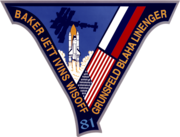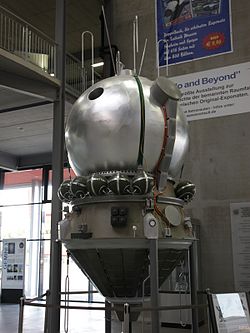STS-81
| STS-81 | |||||
 | |||||
| Uppdrag | 81 | ||||
|---|---|---|---|---|---|
| Rymdfärja | Atlantis (18)[1] | ||||
| NSSDC-ID | 1997-001A[2] | ||||
| Färdens tid | 10 dagar, 4 timmar, 56 minuter, 30 sekunder | ||||
| Uppskjutning | |||||
| Startplats | Startplatta 39B vid Kennedy Space Center i Florida | ||||
| Start | 12 januari 1997, 09:27:23 UTC | ||||
| Landning | |||||
| Landningsplats | KSC, Runway 33 | ||||
| Landning | 22 januari 1997, 14:23:51 UTC | ||||
| Omloppsbana | |||||
| Varv | 160 st[3] | ||||
| Apogeum | 392 km | ||||
| Perigeum | 380 km | ||||
| Banlutning | 51,6° | ||||
| Sträcka | 6,6 miljoner km | ||||
| Dockning | |||||
| Rymdstation | Mir | ||||
| Dockning | 15 januari 1997, 03:54:49 UTC | ||||
| Urdockning | 20 januari 1997, 02:15:44 UTC | ||||
| Tid dockad | 4 dagar, 22 timmar, 20 minuter, 55 sekunder | ||||
| Besättning | |||||
| Befälhavare | Michael A. Baker (4) | ||||
| Pilot | Brent W. Jett (2) | ||||
| Uppdragsspecialister | John M. Grunsfeld (2) Marsha S. Ivins (4) Peter J.K. Wisoff (3) | ||||
 | |||||
| Kronologi Rymdfärjeprogrammet | |||||
| |||||
STS-81 var en flygning i det amerikanska rymdfärjeprogrammet med rymdfärjan Atlantis. Den sköts upp från Pad 39B vid Kennedy Space Center i Florida den 12 januari 1997. Efter drygt tio dagar i omloppsbana runt jorden återinträdde rymdfärjan i jordens atmosfär och landade vid Kennedy Space Center.
Flygningen gick till den ryska rymdstationen Mir.
Målet var att leverera utrustning och förnödenheter till rymdstationen, detta gjorde man med hjälp av en Spacehab-modul placerad i rymdfärjans lastrum.
Besättning
- Michael A. Baker
- Brent W. Jett
- John M. Grunsfeld
- Marsha S. Ivins
- Peter J.K. Wisoff
- Jerry M. Linenger
- John E. Blaha
Väckningar
Under Geminiprogrammet började NASA spela musik för besättningar och sedan Apollo 15 har man varje "morgon" väckt besättningen med ett musikstycke, särskilt utvalt antingen för en enskild astronaut eller för de förhållanden som råder.
| Dag | Låt | Artist/Kompositör |
|---|---|---|
| 2 | "Free Ride" | The Edgar Winter Group |
| 3 | "It Keeps You Runnin’" | The Doobie Brothers |
| 4 | "Hitchin’ a Ride" | Vanity Fare |
| 5 | "Celebration" | Kool and the Gang |
| 6 | "I Got You (I Feel Good)" | James Brown |
| 7 | "Mack the Knife" | Bobby Darin |
| 8 | "Ticket to Ride" | The Beatles |
| 9 | "My Favorite Marcia" | The Allison Brown Quartet |
| 10 | "The Banana Boat Song" | Harry Belafonte |
Se även
Referenser
- ^ NASA Space Shuttle Launch Archive Arkiverad 20 maj 2007 hämtat från the Wayback Machine., läst 28 juli 2016.
- ^ ”NASA Space Science Data Coordinated Archive” (på engelska). NASA. https://nssdc.gsfc.nasa.gov/nmc/spacecraft/display.action?id=1997-001A. Läst 22 mars 2020.
- ^ Manned Astronautics - Figures & Facts Arkiverad 26 september 2015 hämtat från the Wayback Machine., läst 28 juli 2016.
Externa länkar
 Wikimedia Commons har media som rör STS-81.
Wikimedia Commons har media som rör STS-81.
| ||||||||
| |||||||||||||
| ||||||||||||||||||||||||||||||||
Media som används på denna webbplats
The crew patch for STS-81 , the fifth Shuttle-Mir docking mission, is shaped to represent the Roman numeral V. The Shuttle Atlantis is launching toward a rendezvous with Russia's Mir Space Station, silhouetted in the background. Atlantis and the STS-81 crew spent several days docked to Mir during which time Jerry M. Lineger (NASA-Mir-4) replaced astronaut John Blaha (NASA-Mir-3) as the U.S. crew member onboard Mir. The U.S. and Russian flags are depicted along with the names of the shuttle crew.
This mission patch for mission STS-80 depicts the Space Shuttle Columbia and the two research satellites its crew deployed into the blue field of space. The uppermost satellite is the Orbiting Retrievable Far and Extreme Ultraviolet Spectrograph-Shuttle Pallet Satellite (ORFEUS-SPAS), a telescope aimed at unraveling the life cycles of stars and understanding the gases that drift between them. The lower satellite is the Wake Shield Facility (WSF), flying for the third time. It will use the vacuum of space to create advanced semiconductors for the nation's electronics industry. ORFEUS and WSF are joined by the symbol of the Astronaut Corps, representing the human contribution to scientific progress in space. The two bright blue stars represent the mission's Extravehicular Activities (EVA), final rehearsals for techniques and tools to be used in assembly of the International Space Station (ISS). Surrounding Columbia is a constellation of 16 stars, one for each day of the mission, representing the stellar talents of the ground and flight teams that share the goal of expanding knowledge through a permanent human presence in space.
MIR Space Station Emblem
Författare/Upphovsman: Pascal (Flickr user: pasukaru76), Licens: CC0
Vostok spacecraft replica at the Technik Museum Speyer, Germany.
STS-81 crew
STS-82 Mission Insignia
- STS-82 is the second mission to service the Hubble Space Telescope (HST). The central feature of the patch is HST as the crew members will see it through Discovery's overhead windows when the orbiter approaches for rendezvous, retrieval and a subsequent series of spacewalks to perform servicing tasks. The telescope is pointing toward deep space, observing the cosmos. The spiral galaxy symbolizes one of HST's important scientific missions, to accurately determine the cosmic distance scale. To the right of the telescope is a cross-like structure known as a gravitational lens, one of the numerous fundamental discoveries made using HST Imagery. The names of the STS-82 crew members are arranged around the perimeter of the patch with the extravehicular activity's (EVA) participating crew members placed in the upper semicircle and the orbiter crew in the lower one.










